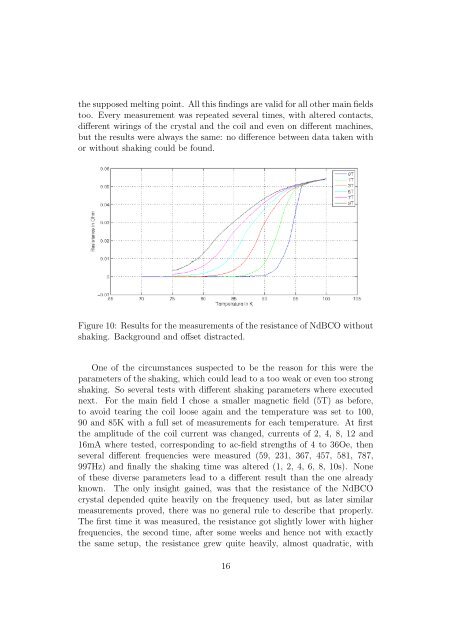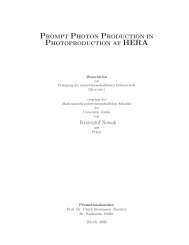Master Thesis Effect of vortex shaking on the ... - Physik-Institut
Master Thesis Effect of vortex shaking on the ... - Physik-Institut
Master Thesis Effect of vortex shaking on the ... - Physik-Institut
Create successful ePaper yourself
Turn your PDF publications into a flip-book with our unique Google optimized e-Paper software.
<strong>the</strong> supposed melting point. All this findings are valid for all o<strong>the</strong>r main fields<br />
too. Every measurement was repeated several times, with altered c<strong>on</strong>tacts,<br />
different wirings <str<strong>on</strong>g>of</str<strong>on</strong>g> <strong>the</strong> crystal and <strong>the</strong> coil and even <strong>on</strong> different machines,<br />
but <strong>the</strong> results were always <strong>the</strong> same: no difference between data taken with<br />
or without <str<strong>on</strong>g>shaking</str<strong>on</strong>g> could be found.<br />
Figure 10: Results for <strong>the</strong> measurements <str<strong>on</strong>g>of</str<strong>on</strong>g> <strong>the</strong> resistance <str<strong>on</strong>g>of</str<strong>on</strong>g> NdBCO without<br />
<str<strong>on</strong>g>shaking</str<strong>on</strong>g>. Background and <str<strong>on</strong>g>of</str<strong>on</strong>g>fset distracted.<br />
One <str<strong>on</strong>g>of</str<strong>on</strong>g> <strong>the</strong> circumstances suspected to be <strong>the</strong> reas<strong>on</strong> for this were <strong>the</strong><br />
parameters <str<strong>on</strong>g>of</str<strong>on</strong>g> <strong>the</strong> <str<strong>on</strong>g>shaking</str<strong>on</strong>g>, which could lead to a too weak or even too str<strong>on</strong>g<br />
<str<strong>on</strong>g>shaking</str<strong>on</strong>g>. So several tests with different <str<strong>on</strong>g>shaking</str<strong>on</strong>g> parameters where executed<br />
next. For <strong>the</strong> main field I chose a smaller magnetic field (5T) as before,<br />
to avoid tearing <strong>the</strong> coil loose again and <strong>the</strong> temperature was set to 100,<br />
90 and 85K with a full set <str<strong>on</strong>g>of</str<strong>on</strong>g> measurements for each temperature. At first<br />
<strong>the</strong> amplitude <str<strong>on</strong>g>of</str<strong>on</strong>g> <strong>the</strong> coil current was changed, currents <str<strong>on</strong>g>of</str<strong>on</strong>g> 2, 4, 8, 12 and<br />
16mA where tested, corresp<strong>on</strong>ding to ac-field strengths <str<strong>on</strong>g>of</str<strong>on</strong>g> 4 to 36Oe, <strong>the</strong>n<br />
several different frequencies were measured (59, 231, 367, 457, 581, 787,<br />
997Hz) and finally <strong>the</strong> <str<strong>on</strong>g>shaking</str<strong>on</strong>g> time was altered (1, 2, 4, 6, 8, 10s). N<strong>on</strong>e<br />
<str<strong>on</strong>g>of</str<strong>on</strong>g> <strong>the</strong>se diverse parameters lead to a different result than <strong>the</strong> <strong>on</strong>e already<br />
known. The <strong>on</strong>ly insight gained, was that <strong>the</strong> resistance <str<strong>on</strong>g>of</str<strong>on</strong>g> <strong>the</strong> NdBCO<br />
crystal depended quite heavily <strong>on</strong> <strong>the</strong> frequency used, but as later similar<br />
measurements proved, <strong>the</strong>re was no general rule to describe that properly.<br />
The first time it was measured, <strong>the</strong> resistance got slightly lower with higher<br />
frequencies, <strong>the</strong> sec<strong>on</strong>d time, after some weeks and hence not with exactly<br />
<strong>the</strong> same setup, <strong>the</strong> resistance grew quite heavily, almost quadratic, with<br />
16
















